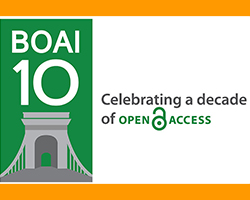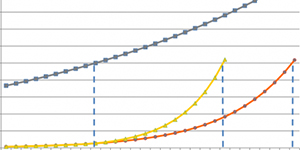
Five Key Moments in the Open Access Movement in the Last Ten Years
Over the last ten years open access movement has rapidly gown and its effect felt in many countries all over the world. The numbers of open access publishers and journals have shown multiple digit growth.
The change open access has witnessed is in many fronts. Institutions and policy makers embraced open access. Researchers have started both to publish on open access and to use research finding published on open access journals for their own research. Many research funding agencies made funding available for open access publishing; in some cases they even demanded mandatory open access publishing.Not only the numbers of open access journals which grew over time, but also the impact and contribution those journals made in the scientific field.
Open access have scored success in many fronts. However, there are some key moments, above all others, which helped the shape of open access movement and industry take current shape. These points indeed helped open access movement gather momentum and gain significant ground in the scientific community. Rhodri Jackson identified five points which played key role in terms of determining success of open access movement over the past ten years. These are:
1. 2004/05 – Nucleic Acids Research (NAR) converts to OA
2. 2008 – National Institutes of Health (NIH) Mandate Introduced
3. 2008 – Springer buys BioMed Central (BMC)
4. 2007 on – Growth of PLOS ONE
5. 2012 – The ‘Finch’ Report
To read more go to Oxford University Press

Open Access and Challenges Holding Back its Success
Open access has been around now for more than a decade. Open access leaders, scholars, scientific journal publishers and analysts believed that the emergence of open access would pose a serious threat to the very existence of traditional journal publishers. Many in the field of academic research anticipated that open access journals would break into the top tier scientific journals and fill the gap that might be left behind by some journals. On the contrary, Bernestein Research declares , ‘11 years after the Berlin Declaration on Open Access, however, the rise of Open Access appears to inflict little or no damage on the leading subscription publishers.’
Why subscription journals such as Elsevier and Springer are still growing and they are making hefty profit ( their profit margin is usually bigger than that of oil companies)? Why open access journals have failed to get significant ground in the scientific publishing world by pushing aside traditional publishers which charge a high price for their articles? There are some explanations for this.
Subscription based publishers managed to keep threat that has come to existence with the emergence of open access journals at bay using various techniques. They have, to begin with, adopted hybrid model of publishing. Creation of hybrid journals helped big publishers in two ways. Firstly, they earn profit through APC (articles processing charges). There are speculations that those publishers may be ‘double dipping’ i.e. charging APC and subscription fees on the same article. Secondly, it helped their image. By embracing hybrid publishing model subscription dependent journals appear to be open access friendly. These ways they claim to be compliant with national and the EU open access policies. Those policies require researchers to make tax payers funded research to be freely accessible to general public; mostly after max embargo period of one year.
Lack of clarity in defining core goal of open access is another problem dragging the progress of open access,according to Bernestein Research. Open access definition and objective widely differ depending on whether you discuss issues related to open access with a librarian, an economist or an activist. To achieve big, irrespective of background and career, the goal open access aspires to achieve should be one and the same.
Countries have different policies and priorities as far as open access are concerned. This is another area of challenge. For instance, the commitment to open access that the US government shows is not as strong as the Europeans commitment. Policy of the EU and many European countries encourages gold open access through APC funding. Whereas Green open access with embargo period appears to be good enough for Americans. They seem not to worry about embracing Gold route at least for the time being.
Another challenge, which is systematic in nature, is issue of tenure and career security. Publishing on high impact factor journals such as Nature and Science comes with high reward as far as securing early career and grant are concerned. Having one of those journals name in your resume when you apply for a job can make a lot of difference. Prestige and reward plays a significant role in academic circle. It’s a hard fact. That’s why researchers work so hard to put their name on those journals despite having many open access journals around them.
Until research centers, grant providers and universities start different approach of looking at how to recruit, promote and reward, subscription based journals will grow at the expense of open access ones. There is a hope that those institutions will change their current approach. But this takes bold and brave leadership. It can be done. It will take time, though.

Politicians are So Keen on Open Access. But why?
People sometimes speculate on why policymakers, including elected politicians, are so keen on open access (i.e. giving people free access to the output of researchers – especially taxpayer-funded research), which has made enormous strides in recent years.
It may seem obvious to some readers of this blog, although there are various different potential reasons, such as a desire to ensure research undertaken in the UK is widely cited and wanting to help small businesses find out about the latest research. But there is another – more mundane – reason that is often overlooked.
In their day-to-day policy work, politicians and their advisers can find it hard to access academic research themselves. They have no institutional log-ins and, while the Libraries of the House of Commons and the House of Lords subscribe to some journals, it is an eclectic and seemingly random list. If you want to know why policy is not always rooted in evidence, this is one small reason why. Civil servants face a similar challenge. When I was a special adviser, and therefore a temporary civil servant, I had no routine access to the output of peer-reviewed journals, even though research came within my Minister’s brief. Occasionally, I would ask to see a specific article and, although the department did usually end up buying it eventually, it was a tortuous and time-consuming process as no one ever knew which budget should cover the cost (normally around £25).
Some evidence on this problem was offered in a speech by David Willetts when he was the Universities and Science Minister. He spoke about the challenges he faced when writing a book before taking ministerial office: I had my own experience of being an outsider when I was writing my book, ‘The Pinch’, on fairness between the generations. It was very frustrating to track down an article drawing on publicly funded research and then find it hidden behind a pay wall. That meant it was freely accessible to a professional in an academic institution, but not to me as an independent writer. That creates a barrier between the academic community, the insiders, and the rest of us, which is deeply unhealthy.
It may be that the Westminster and Whitehall authorities should have fixed this issue in the past, in the interests of good public policy and proper scrutiny of the executive by the legislature, by paying publishers properly for access to more journals in the way university libraries paid (and pay)…but I still can’t help thinking the single thing those who dislike open access could have done to slow its pace would have been to have given generous terms to policymakers a long time ago.

Since the inception of open access movements in the early 2000s, many things have happened around the scientific community and the scholarly publishing world. Universities and research institutions have gradually embraced the principles of open access and hence put institutional repositories in place. Many of them are European and American universities, though. Countries have adopted open access policies which required all tax payers funded researches accessible free of charge for end users.
Despite initial resistance to the movement, heavy weight scholarly publishers such as Elsevier and Nature have shown, though it is limited, interest at least for the time being to go with hybrid model of journal publishing. Publishers that adopt hybrid model have both open access and access restricted journal articles. Those classic publishers use a mix of gold open access approach and embargo terms to give limited access to some articles that they publish in an open access environemnt. With the first one, they charge article processing charges (APC), authors pay the publishers for the article they publish on one of their scientific journals so as to give end users free access to the published articles. This is Gold open access approach- here authors carry burden that comes with article publishing and dessimination.
The second approach is which is embargo period a way through which end users access articles free of charge once embargo period is lifted- embargo period usually lasts for one year. While papers are under embargo period, access to those articles is only possible through subscription.
Open access movement is growing. Open access journals are flourishing-both in developed and developing countries. Yet still, after more than a decade long journal with theories and practices of open access, many remained skeptical about the quality of open access journals. The cynics are not silenced despite gains made and quality demonstrated by major players in the field: BioMed and PlosOne managed to build trust and gain confidence from the scientific community. The number of open access citation and download has shown remarkable increase. Their impact factor has improved significantly. Though, all open access journals are not of the same standard and do not adhere to strict scientific articles publishing code of conduct such as undergoing rigorous peer-review process.
For more on this subject read an article from the Economist.

Open Access Journals Revenue will triple by 2017
Simba Information has found out that the number of Open Access (OA) publishers and the revenue the sector generates has shown remarkable growth. This is mainly in the area of science, technical and medical (STM) journal publishers. The result has been achieved as a result of intensive global campaign by scientists, librarians, research funders and universities- according to Simba Information.
Samba Information estimates show that revenue of Open Access publishers increased by 32.8% in 2013. The revenue is principally generated through article processing charges (APC) that authors pay publishers in order to publish their articles on an Open Access journals.
Despite this rapid growth, OA revenue still only represents 2.3% of global 2013 STM journal sales, according to Simba Information’s research. But this revenue stream is a bright spot against a flat market. While STM journal revenue is expected to increase at a compound annual rate of between 1% and 2% between 2011 and 2017, OA revenue is expected to more than triple in that period.
Open access is already having a bigger impact in terms of publishing output. By some estimates, OA already represents 10% to 20% of all research articles published.

